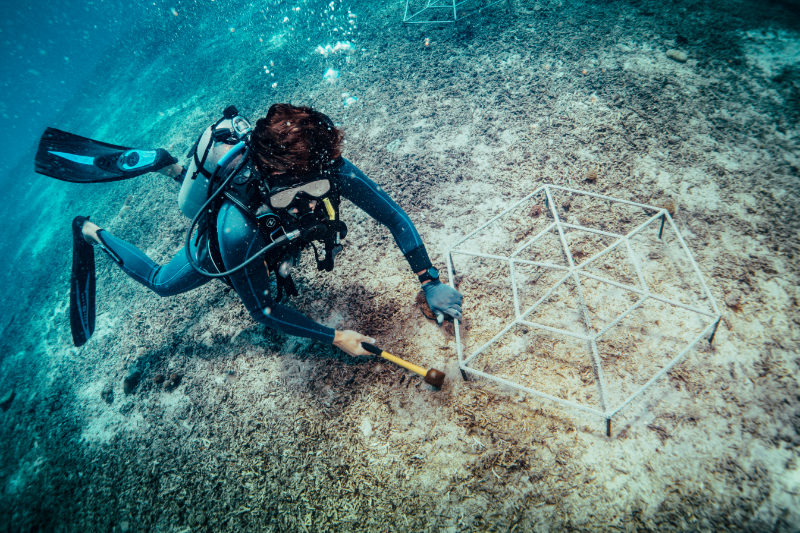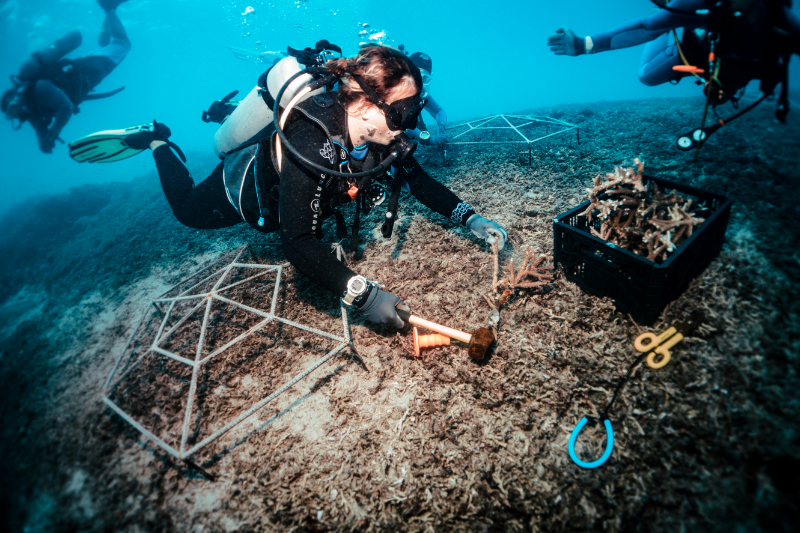Overview
The Nusa Islands Restoration Project was started in 2018 as an attempt to reverse the degradation of reef areas along the northern coastline of Nusa Penida Island, Bali, Indonesia. The reef is an important source of income from tourism activities (diving & snorkeling), but has been subjected to a variety of impacts resulting in mechanical damage and unstable rubble. Impacted areas are not recovering naturally, but are rather increasing in size. Therefore, restoration is needed in an area of reef flat and reef slope in order to stabilize the rubble substrate and stimulate coral recovery. The project started in April 2018 and is an ongoing effort spanning an area of approximately 150m x 20m of reef. The project includes physical components (coated metal frames and mesh rubble fencing) as well as biological components (coral transplantation, coral nursery).
Quick Facts
Project Location:
Nusa Islands, Bali, Indonesia, -8.6785828, 115.4555858
Geographic Region:
Asia
Country or Territory:
Indonesia
Biome:
Coastal/Marine
Ecosystem:
Coral Reef, Seagrass & Shellfish Beds
Area being restored:
Subtidal coral reef flat and slope between 4m- 10m depth. Impact area being restored is 150m x 20m
Project Lead:
Blue Corner Marine Research
Organization Type:
Consultant / Consulting Company
Project Partners:
Blue Corner Marine Research (lead);
Lembongan Marine Association (community organization)
Location
Project Stage:
Implementation
Start Date:
2018- 03
End Date:
2023-12
Primary Causes of Degradation
Fisheries & Aquaculture, Urbanization, Transportation & Industry, OtherDegradation Description
The restoration site has been subjected to several impacts resulting in mechanical damage and unstable rubble:
- Anchoring of boats and inadequate moorings
- Clearing coral areas for pontoon tourism
- Clearing of reef at areas for seaweed farming
- Increased erosion from reinforced shoreline
- Historical dragging of fish traps across reef flat
The rubble area has shown little signs of natural recovery over the previous seven years that the site has been observed. Rubble areas are highly mobile and are showing signs of eroding down the reef slope increasing the size of the impact footprint.
Little recruitment survival are seen in rubble areas. There is reduced reef health compared to adjacent reef areas, due to the impact site being 100% rubble.
Defining the Reference Ecosystem
The reference ecosystem is based on diverse sources of information (e.g. multiple extant reference sites, field indicators, historical records, predictive data).Reference Ecosystem Description
Reference ecosystem was based on surveys of adjacent reef areas, underwater photos of the area from previous years, and identification of coral rubble skeletons present at restoration site:
The targets for restoration were set from surveys of adjacent reef along the coastline from the restoration site. This area has the same depths, current & wave exposure and reef slope angle. We assume historic base-point of the restoration site would have had similar species composition. Our aim is therefore to restore hard coral community to a similar point.
This adjacent reference site was also used as the donor site for sourcing coral transplants.
Project Goals
The primary goals are to increase ecosystem function and habitat complexity. It is an important reef to the area for tourism, as well as ecologically important being within a marine park.
The primary methods are to introduce simple structures to provide the framework for which fast growing hard coral species can then use for expanding across the rubble area. The foundation coral species will then attract settlement of successional communities in turn increasing ecosystem function.
Monitoring
The project does not have a monitoring plan.
Stakeholders
The Lembongan Marine Association together with Komunitas Penyulam Lembongan are committed to reducing impacts on the reef through community education and adopting codes of conduct for responsible marine tourism operators. We work together with these local community organizations and have been conducting workshops for the local dive and marine tourism professionals in these two organizations to train them in basic marine ecology and coral restoration techniques.
This project is financed through private donations, fundraising events and volunteers. Our aim is to use a technique which is inexpensive and feasible with the personnel and resources already present in the community.
How this project eliminated existing threats to the ecosystem:
The marine park management has implemented a zoning system within the park as to which activities are permitted within zones. The restoration site has been designated protected area and so the previous boat anchoring and fishing impacts are now reduced.
How this project reinstated appropriate physical conditions (e.g. hydrology, substrate)",:
The site is in a high current area at the terminus of the Indonesian-Through-Flow ocean current. Therefore the structural restoration techniques required needed to be designed to handle strong forces from high water currents.
Broken coral substrate is unstable and shifts in the currents causing erosion to adjacent areas. Therefore substrate stabilization was first required before beginning biological restoration.
How this project achieved a desirable species composition:
Target species composition based on surveys of adjacent healthy areas of reef. A list of target species was compiled in appropriate proportions according to water depth and reef zone.
Additionally studies in recovering areas were done to determine successional coral community species so that habitat forming foundation species were utilized for the initial biological restoration efforts ( transplantations).
How this project reinstated structural diversity (e.g. strata, faunal food webs, spatial habitat diversity):
Many coated metal frames measuring 1 sq meter each in size were used in a modular fashion to reinstate reef structure. Additionally rubble fencing was used to trap and stabilize shifting rubble.
Immediately after installing structures mobile organisms (certain fish and invertebrates) began to utilize the site.
How this project recovered ecosystem functionality (e.g. nutrient cycling, plant-animal interactions, normal stressors):
By transplanting select species of coral, it stimulated natural settlement of secondary substrate-forming species (including soft corals, sponges, hydroids, etc). Mobile grazing organisms (such as parrotfish and butterfly fish) began to use the area and attracted both predators and stimulated the settlement of invertebrates.
How this project reestablished external exchanges with the surrounding landscape (e.g. migration, gene flow, hydrology):
The site is being monitored to determine if the transplanted corals will begin sexually reproducing in the next spawning season. Transplants were taken from multiple parents so that the restoration plan included genetic diversity of corals.
Activities were undertaken to address any socio-economic aspects of the project:
Regular training events take place with local marine tourism operators.
Ecological Outcomes Achieved
Eliminate existing threats to the ecosystem:
Anchoring and illegal fishing are reduced in the area, however enforcement is a challenge for the marine park so some destructive activities persist. With increases in tourism in the area it will be a continuous challenge to promote environmentally responsible behaviours by both tourists and the business operators.
Reinstate appropriate physical conditions",:
The structures which have been introduced into the restoration site have been trapping rubble and creating a topographical complexity to the reef which did not exist in its disturbed state.
Achieve a desirable species composition:
Settlement of secondary substrate-forming species is beginning to happen both upon the modified substrate as well as trapped rubble patches.
Reinstate structural diversity:
Structure and habitat complexity has increased as is measured during reef rugosity measurements. Also can be seen by site usage by fish and other mobile organisms.
Recover ecosystem functionality:
By transplanting select species of coral, it stimulated natural settlement of secondary substrate-forming species (including soft corals, sponges, hydroids, etc). Mobile grazing organisms (such as parrotfish and butterfly fish) began to use the area and attracted both predators and stimulated the settlement of invertebrates.
Reestablish external exchanges with the surrounding landscape:
The area of reef has a high level of connectivity with surrounding reef areas so we see a lot of overlapping usage by mobile organisms between the restoration and healthy reef areas.
Factors limiting recovery of the ecosystem:
The project is run by donations and volunteers, so limited financial resources allow only small areas of reef to undergo restoration at a time.
Socio-Economic & Community Outcomes Achieved
Economic vitality and local livelihoods:
Local marine tourism professionals have been visiting the site regularly with their guests. Tourism is the sole industry in the area so empowerment of the local community to believe that degraded ecosystems can be restored is one of our primary goals.
Provision of basic necessities such as food, water, timber, fiber, fuel, etc.:
The local community are starting to understand that a healthy coral reef means satisfied tourists and returning customers to their businesses.
Sources and Amounts of Funding
The project is funded by donations and run by volunteers. Blue Corner Marine Research (the lead organization in the project) conducts internship training programs and scuba diving courses for tourists which help fund the project as well as provide the human resources for monitoring and maintenance of the project.
Other Resources
http://bluecornerconservation.org/coral-reef-restoration
Related Research
We are monitoring the project for many parameters such as coral growth, recruitment, and fish utilization. As well as have pilot projects running using multi-species vs single species transplants. However the project is being done with the primary goal to restore the area of reef rather than a research project.Primary Contact
Name:
Andrew CF Taylor
Affiliation:
Director, Blue Corner Marine Research
City:
Nusa Lembongan
State:
Bali



